Oct 30
Posted: under Activities, Plantlife, Wildlife.
Tags: Activities, beauty, dragonfly, native plants, natural water, photography October 30th, 2009
Instead of raining yesterday as the front came through, the sky slowly cleared from the west, and today dawned chilly and clear. While Richard worked on fence, I put on rubber boots and went out to see if anything’s drying out yet. [...more]
Instead of raining yesterday as the front came through, the sky slowly cleared from the west, and today dawned chilly and clear. While Richard worked on fence, I put on rubber boots and went out to see if anything’s drying out yet.
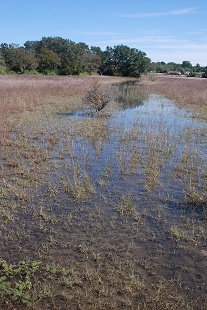
Read the rest of this entry »

Oct 20
Posted: under photography, Plantlife, Water.
Tags: beauty, grass, native plants, photography, prairie restoration, rain October 20th, 2009
An introduction to some more of our “big” grasses, now flowering beautifully after the rain. Two are climax tallgrasses, and one is (in my opinion) one of the most beautiful grasses in the country and deserves to be used more as a landscape accent. Meet Lindheimer Muhly (Muhlenbergia Lindheimeri). All the Muhlys are pretty grasses; […] [...more]
An introduction to some more of our “big” grasses, now flowering beautifully after the rain. Two are climax tallgrasses, and one is (in my opinion) one of the most beautiful grasses in the country and deserves to be used more as a landscape accent.
Meet Lindheimer Muhly (Muhlenbergia Lindheimeri). All the Muhlys are pretty grasses; some are more striking than others, but Lindheimer Muhly is the queen of the lot:
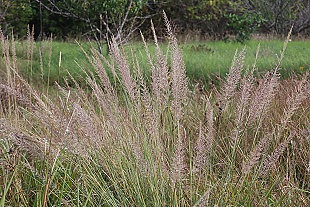
Read the rest of this entry »

Oct 12
Posted: under Plantlife.
Tags: beauty, native plants October 12th, 2009
For the past week, I’ve been in New York State, first visiting a friend in Oswego, with several walks through the woods at the Rice Creek Field Station, and then traveling by train down the Mohawk and the Hudson Rivers, and finally here in NYC, where I spent several hours yesterday at the Brooklyn Botanical […] [...more]
For the past week, I’ve been in New York State, first visiting a friend in Oswego, with several walks through the woods at the Rice Creek Field Station, and then traveling by train down the Mohawk and the Hudson Rivers, and finally here in NYC, where I spent several hours yesterday at the Brooklyn Botanical Gardens.
Read the rest of this entry »

Oct 08
Posted: under Climate Change, Plantlife.
Tags: beauty, climate October 8th, 2009
Taking the train from Texas to the NE has let me watch autumn develop: just starting in Texas, more and more advanced as we went north, and here, in upstate NY, gorgeous with sugar maples, sumac, poison ivy (leaves the size of dessert plates), things with berries I don’t know, green moss and ferns, russet […] [...more]
Taking the train from Texas to the NE has let me watch autumn develop: just starting in Texas, more and more advanced as we went north, and here, in upstate NY, gorgeous with sugar maples, sumac, poison ivy (leaves the size of dessert plates), things with berries I don’t know, green moss and ferns, russet this and golden that.
I chatted with another prairie person in St. Louis at the Ninc conference and in Oswego visited Rice Creek Field Station and met the new director, whose previous work was in Chihuahuan Desert ecology–and then walked the trails there. Perfect. She’s aware of research in Mexico on the effect of climate change and has promised to send me some references.
Meanwhile, I’m hearing reports from home of more rain and thus the creek may well still be running when I’m home again, a week from this Sunday.

Sep 27
Posted: under photography, Plantlife, Wildlife.
Tags: beauty, butterflies, native plants, photography September 27th, 2009
Though we lost the two planted cypresses to the drought, and some of the water iris we’d planted in the “swamp”, this one survived and is now coming back up from the corm. The water here is about an inch deep–this is an overflow/seep channel off the main creek; 8.5 inches didn’t put more than […] [...more]
Though we lost the two planted cypresses to the drought, and some of the water iris we’d planted in the “swamp”, this one survived and is now coming back up from the corm.
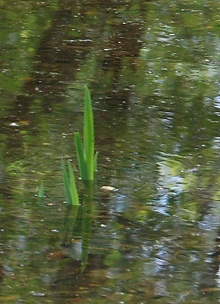
The water here is about an inch deep–this is an overflow/seep channel off the main creek; 8.5 inches didn’t put more than a flood pulse through it, but the final 1.5 inches left this wide shallow pool…and a brave little iris.
Read the rest of this entry »

Sep 25
Posted: under photography, Plantlife, Water.
Tags: beauty, native plants, photography, prairie restoration September 25th, 2009
Altogether, we’ve had 10 inches of rain since the big rain started. Though it’s too late for some things, others have recovered well. The yellow flowers are two-leaf senna, and the pink is the rose-oxalis that usually blooms in the early spring. [...more]
Altogether, we’ve had 10 inches of rain since the big rain started. Though it’s too late for some things, others have recovered well.
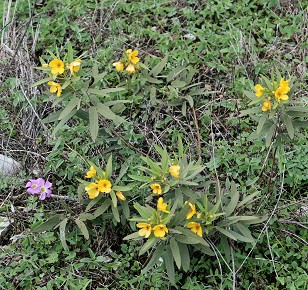
The yellow flowers are two-leaf senna, and the pink is the rose-oxalis that usually blooms in the early spring.
Read the rest of this entry »

Sep 18
Posted: under Land, photography, Plantlife, Water.
Tags: beauty, insect, native plants, observation, photography, Weather September 18th, 2009
The water that didn’t run off soaked in; it’s amazing that in one week it’s turned so green. The darker streak in the middle distance is the grass waterway when it rains and right now is just dry enough to walk on in regular shoes. [...more]
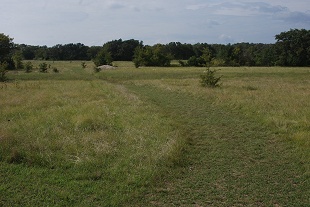
The water that didn’t run off soaked in; it’s amazing that in one week it’s turned so green. The darker streak in the middle distance is the grass waterway when it rains and right now is just dry enough to walk on in regular shoes.
Read the rest of this entry »

Jun 12
Posted: under Activities, Plantlife.
Tags: Activities, water resource management June 12th, 2009
Because there’s no permanent natural water on our place, the main aquatic habitat we can provide for wildlife is near the house (where, if we don’t collect enough rainwater, we can use city water–in fact, the water garden began with city water supply.) It has an upper, stream-like section (small pools with low “falls” into […] [...more]
Because there’s no permanent natural water on our place, the main aquatic habitat we can provide for wildlife is near the house (where, if we don’t collect enough rainwater, we can use city water–in fact, the water garden began with city water supply.) It has an upper, stream-like section (small pools with low “falls” into each other, all in the shade) and a bottom pool that’s a 10×20 foot lily pond–with wide shallow ledges around the edge and a deep “trench” in the middle for the lilies.
To provide some vertical plantlife for dragonflies, damselflies, and other insects that need emergent vegetation, we added in pickerelweed and water iris. The water iris turned out to be very aggressive. Periodically we have to cut it back, and that’s a huge chore.
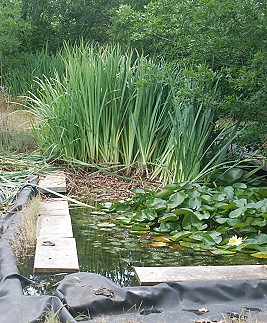
Read the rest of this entry »

Jun 04
Posted: under photography, Plantlife.
Tags: beauty, native plants, photography June 4th, 2009
Since it looks like the rain has left us for the summer (hope not, but the long-range predictions aren’t good), I’m posting flower pictures while we have some–and we have some. An increaser in the west grass, mentioned before, is the Illinois Basketflower, Centaurea americana. this tallish forb’s buds look a lot like thistles: [...more]
Since it looks like the rain has left us for the summer (hope not, but the long-range predictions aren’t good), I’m posting flower pictures while we have some–and we have some.
An increaser in the west grass, mentioned before, is the Illinois Basketflower, Centaurea americana. this tallish forb’s buds look a lot like thistles:
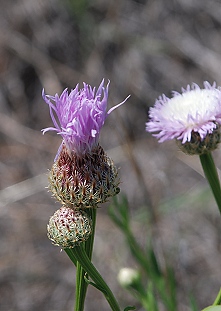
Read the rest of this entry »

Jun 04
Posted: under Activities, Plantlife.
Tags: Activities, beauty, land management, native plants, prairie restoration June 4th, 2009
If land managers had ten thousand years to play with the land, prairie restoration would be a lot easier, even if they had to start with an overgrazed, eroded, compacted, heavily-invaded, polluted mess. But we don’t. So some basic principles have been laid down–initially during research on northern prairies–that now govern most prairie restoration projects: […] [...more]
If land managers had ten thousand years to play with the land, prairie restoration would be a lot easier, even if they had to start with an overgrazed, eroded, compacted, heavily-invaded, polluted mess. But we don’t. So some basic principles have been laid down–initially during research on northern prairies–that now govern most prairie restoration projects: physical removal of invasive woody plants by fire (cheap) or various mechanical clearing methods (more expensive) , grazing management to interrupt succession, physical disturbance of the soil (discing, for instance) to induce germination of dormant seeds.
Read the rest of this entry »








